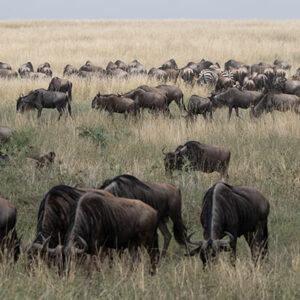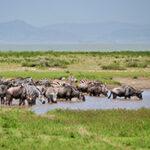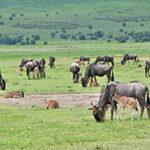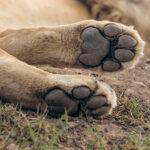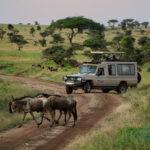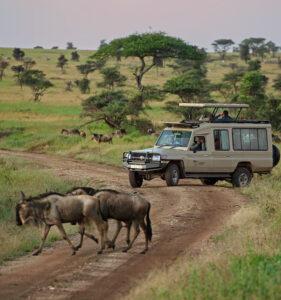
Explore the Serengeti together with your experienced guide.


Witness a journey of life and death – the Greatest Show on Earth
In Northeast Tanzania, you can witness one of the most impressive animal migrations on Earth. The Great Migration of wildebeest and zebras features ~2 million animals travelling ~1000km in a clockwise direction in search of fresh grass and breeding grounds. Their journey creates an interaction between predator and prey of massive scale, making a Tanzania migration safari a dream experience for nature and wildlife enthusiasts. Witnessing this spectacle of life and death can play on your emotions, but it’s a natural wonder that’s truly worth beholding.
We spent 7 nights in tents amidst the wildebeest migration. The animals could be seen and heard day and night and many herds consisting of thousands of animals travelled through the areas around us on their way to the Sand River and the Masai Mara. It was an absolutely perfect holiday and our guide Wilson and our cooks Ernest and Innocent looked after us very well. We spent ten days on two special campsites. Thanks to the equipment provided by Tanzania-Experience we could spend time completely alone in the bush, without having to stay at the public campsites.Rolf | Great Migration Mobile Explorer Camping Safari
You can see the Great Migration all year round – depending on the month, the herds are in different areas of the vast ecosystem. Generally, the best time to see the wildebeest migration in northern Tanzania is between June and October. This period coincides with the dry season. During this time the wildlife congregates around water sources, and the sparse vegetation creates excellent conditions for observing animals. The wildebeest migration moves from the south to the north in a clockwise direction, so you will have ample opportunities to see this phenomenon at various locations in the park. There is no telling when exactly the famous river crossings take place, but your chances are best during the dry season months.
June until AugustBest time to see the migration in the Serengeti
June until AugustBest time to see the migration in the Serengeti
June to October is Tanzania’s dry season. During this season daytime temperatures range from 25°C (77°F) to 28°C (82°F) in the Serengeti National Park. Humidity levels are low, and the chance of rain is minimal. Evenings and early morning temperatures can be cold, especially if you are at a higher altitude like the rim of Ngorongoro Crater. Warm clothes are essential for early morning drives and for stargazing at night. It is the most popular time for a Tanzania migration safari.
March until MayBest time to see the wildebeest rut
March until MayBest time to see the wildebeest rut
Tanzania experiences a prolonged rainy season with heavy daily rainfall, particularly in April and May. Despite the rain, the daytime temperature remains warm. This season presents excellent photography opportunities with stunning thunderstorms, towering cloud formations, and lush green landscapes. Fewer visitors are in the Serengeti National Park during this season, making it a preferred time for some visitors to plan their visit.
In the Serengeti National Park, you’ll find a range of options from campsites to luxury lodges with stunning views and excellent service. For a truly unique experience, consider our Mobile Explorer Camp. It is set up in some of the most remote yet best wildlife-viewing areas of the park and offers all the creature comforts of home. You’ll stay in a 3m x 3m tent with proper beds and linen and you can enjoy a hot shower before a candle-lit dinner. Staying on private campsites, you have a remote and exclusive experience during the otherwise busy migration safari season in the Serengeti.
It’s impossible to express in words the feeling of seeing the migration firsthand. The sheer magnitude of the event is breathtaking. An endless horizon of grasslands, long columns of wildebeest making their way through the landscape and an abundance of predators on the ground, in the air, and in the rivers is truly remarkable.
The wildebeest migration draws numerous visitors to East Africa every year. Consequently, migration safaris get booked up fast. To avoid disappointment, we suggest booking your safari at least six months in advance. Even better would be to plan a year ahead of your desired travel date. However, if you are flexible about the type of accommodation that you stay in, you could be lucky to find last-minute options.
For nature enthusiasts, watching a river crossing is like witnessing a world cup final. This is a highly anticipated event and it’s important to expect a large number of other 4×4 vehicles parked along the river banks waiting to witness this spectacular sight. The migration also occurs during the most popular time to visit Tanzania for a general safari, so parts of the park can get busy during this period. Another spectacular event with fewer people to consider is the wildebeest calving season in January and February.
When it comes to seeing the wildebeest migration, there isn’t one perfect time and place. It’s important to consider what you want to see and use that information to determine when to visit. Once you have a rough idea of what you would like to see and when you would like to go, we can help to tailor your safari for you.
When planning your trip, it’s crucial to bear in mind that nature, particularly river crossings, can be unpredictable. You may find yourself waiting around for hours with hundreds and thousands of wildebeest gathering at the river banks, but none of them daring to take the plunge. Certainly, the presence of crocodiles and hippos, a varied wildlife population, and countless wildebeest on the plains can keep you entertained while you wait.
Although the well-known migration events take place between June and October, the journey towards breeding grounds and new pastures happens throughout the year. The following are other significant moments in the wildebeest migration calendar.
January to February
During the wildebeest calving season, which occurs in the Ngorongoro Conservation Area and southern Serengeti National Park, ~500,000 newborn calves are born. This attracts a large number of predators.
March to April
In March, the calving season draws to a close, and the wildebeest commence their journey northwards towards Central Serengeti.
May to June
The wildebeest rut, or mating season, takes place in May. As long columns of wildebeest make their way through the landscape, males clash heads in a battle for a group or corral of females. Often distracted, with more than two males in the mix, they can be taken prey. By mid-May, the wildebeest start to mass in Western Serengeti and the river crossings at the Grumeti River begin.
July to October
In July, the wildebeest migrate to the northern Serengeti and the renowned Mara River crossings commence. Subsequently, crossings over the Talek River also take place. The timing of these events is believed to be contingent upon the onset of the rains. As the months pass, the wildebeest make their way into Kenya’s Masai Mara National Reserve.
November to December
During this period the short rains create a flush of green growth and trigger the wildebeest in the Masai Mara to return to the Serengeti National Park.
From July the wildebeest continue north and eventually cross over the border into Kenya, where they arrive at the Masai Mara National Reserve. Fortunately, our sister company, Kenya-Experience, can assist you in continuing to follow their journey into Kenya.
After visiting the Serengeti, you stop at a secluded location at Lake Victoria, where you can take a traditional canoe trip out onto the lake to observe how local fishermen work. Afterwards, you will journey to the Masai Mara National Reserve and spend dedicated time in this enchanting park to follow the wildebeests’ journey.
During your stay, you will also experience superb wildlife watching where you can see lions, elephants, buffalos, and leopards to name a few. After a few magical days, you will drive to Nairobi to conclude your trip or return to Arusha.
A crossing-border migration safari to Tanzania as well as Kenya affords you the best chances to see a river crossing and experience the Great Migration in all its glory.
We will get back to you within 2 working days.
You are currently viewing a placeholder content from Instagram. To access the actual content, click the button below. Please note that doing so will share data with third-party providers.
More InformationYou are currently viewing a placeholder content from Google Maps. To access the actual content, click the button below. Please note that doing so will share data with third-party providers.
More Information





